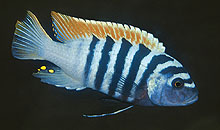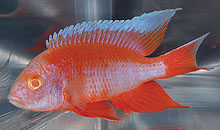WHAT'S NEW ACROSS THE WORLD
Select date in side bar to go to a What's New of previous issues
| What's New
©by Laif DeMason
The issue marks Cichlid News twentieth year! It doesn’t seem that long, but time flies when you’re having fun. I have now written 76 regular (and four pre-magazine) ‘What’s New’ columns for Cichlid News. People ask me how do you come up with all the species to write about. Well, I have been importing cichlids professionally since 1983 and have over 3250 shipments and about 70,000 boxes under my belt through the years. In the early days of rift lake cichlids export, one or two new species from Malawi or Tanganyika per year was the norm. I remember when the sulfur head peacock (Aulonocara maylandi) and the Neolamprologus pulcher ‘Daffodil’ were the new fish for that year. Stuart Grant once told me on a trip to Malawi in 1989 that his divers knew of a few dozen species that were new and uncollected, but saved from export so that new fishes could be rationed out. Well the interest in cichlids since increased and the demand created new explorations and exporters and thus hundreds of new varieties over a ten-year span. During many of the early to mid 1990’s years, new varieties were so numerous, they were almost a blur. Over the last several years, demand has faltered and costs increased thus fewer new areas were explored and collected. Recently, I sometimes find I cannot really say there were 16 new species or varieties collected or produced over the three months between columns. Fortunately there are many newcomers in the cichlid hobby and they are actually unfamiliar with some of the species from the past, especially when that species is not often seen or produced. So what is old becomes what is new (to others). The fascinating aspect about cichlids is that there are so many species and species groups suitable for aquaria, that when one group is out of favor, another group is popular. It is all cyclical (or cichlidcal?). I always try to at least feature fishes that are actually available to be purchased, which I hope is helpful from the hobbyist point of view. Newly arrived fishes are not often in their best condition or colors, so please excuse some of my photos. Alternatively there is now the internet to peruse and search for better photos of new cichlids. However, it is up to the hobbyist to separate the fluff from the reality.
Here’s “what’s new” on the cichlid scene:
|
Neotropics
Collecting and exporting from South America is in full swing. Moreover hundreds of captive bred varieties are offered from various sources worldwide. There is something for every taste in the new world cichlid selections nowadays.

There are dozens of varieties and combinations of varieties of man-made angelfish (Pterophyllum scalare). Here an interesting and beautiful form of a white ‘pearl scale’ strain. Each strain can come with either regular finnage (here) or the elegant veil tail finnage.
|

Also, there are dozens of man-made varieties of Symphsodon discus. Some quite stunning like this blue diamond type with fine thin lines on its face and gill plate. Body shape and fins length can also be combined with different color patterns.
|
Tanganyika
Energy and fuel costs keep climbing higher in the countries surrounding Lake Tanganyika. Exporters have been willing to absorb the costs over the last few years, however they no longer can and thus cichlid prices have gone up from both Burundi and Tanzania. Freight costs from East Africa have increased as high as 80% since last March as well. Importers have absorbed the past freight increases but can no longer do so. In short, wild Tanganyika fishes will cost more no matter where you buy them!
|
WHAT'S NEW: LAKE TANGANYIKA
|

Shell dwellers remain popular and wild individuals are still available. Here, a recently imported Lamprologus brevis ‘sunspot’ collected at Namansi, Tanzania, so named by its characteristic mid body blotch.
|

Imported several years ago from Zambia, but not exported since, Altolamprologus compressiceps ‘coal black’ is a dark black form of the popular species and has arrived again.
|

Not often imported, since nearby variants are usually caught instead, is the Tropheus moorii from Malasa Island, Tanzania. Note the dark red markings around the head area and the typical “rainbow” body markings along with a yellow dorsal fin.
|

Reportedly from south of Kasanga, Tanzania, Julidochromis marlieri has appeared in recent shipments. The color variety of this marlieri has more of a marbled pattern compared to the standard Burundi form. However the body size of the two wild varieties is comparable.
|
Lake Malawi
Options for Lake Malawi collectors and exporters are limited. Costs continue to go up and demand down. Some exporters have lowered their prices somewhat, but there is not enough margin to continue to charge less as freight increases continue to make any discount a wash in the importers’ view. Reliance on captive bred items seems to be the current choice over wild fishes.

Metriaclima pyrsonotos collected from Eccles Reef, Malawi, in the southern arm of the lake, sports a red dorsal fin along with a yellow chin. Oddly enough, there is a similarly-colored species a couple of hundred miles away near Chilumba and Lundo Island. Photo by A. Konings.
|

Only available from captive bred sources, Aulonocara Albino Eureka is an impressively colored form. This fish is not found in the lake and the strain was originally created from A. jacobfreigbergi stocks. Captive raised production is often low with few progeny.
|
Select date in side bar to go a What's New of previous issues
|







